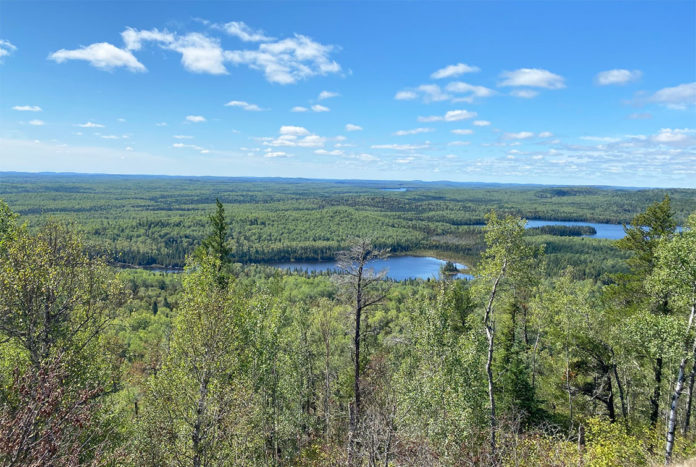DULUTH, MN – Chairwoman Cathy Chavers of the Bois Forte Band of Chippewa, Chairperson Kevin R. DuPuis, Sr. of the Fond du Lac Band of Lake Superior Chippewa, and Chairman Robert Deschampe of the Grand Portage Band of Lake Superior Chippewa (the “Bands”) and the USDA Forest Service Regional Forester Gina Owens and Superior National Forest Supervisor Tom Hall, signed a Memorandum of Understanding (MOU) to provide for co-stewardship and protection of the Bands treaty-reserved rights under the 1854 treaty within the Superior National Forest. The agreement is the first of its kind between the Bands and the Superior National Forest.
On September 30, 1854, the Bands entered into a treaty with the United States whereby they ceded to the United States ownership of their lands in northeastern Minnesota. Under the treaty, the Bands retained their inherent rights to hunt, fish, and gather in the 1854 ceded territory. This ceded territory encompasses approximately 6.2 million acres of land in what is now considered present-day northeastern Minnesota, including 3.3 million acres in what is now called the Superior National Forest. The 1854 treaty is an express recognition of the government-to-government relationship between the Bands and the United States.
The MOU recognizes the Bands as original stewards of lands now encompassing the Superior National Forest and outlines procedures to ensure that tribal input is meaningfully incorporated into Forest Service decision-making. This includes robust processes for meaningful and early tribal consultation on Forest Service decisions that may impact the Bands’ treaty-reserved rights. It also includes provisions for designation and protection of culturally sensitive areas within the forest, coordination on forest management objectives, and tribal-Forest Service training. Through the MOU, the Bands and the Forest Service also commit to jointly pursuing funding opportunities to support co-stewardship within the Superior National Forest. Through this agreement, the Bands will assist the Forest Service using deep place based tribal traditional ecological knowledge to support shared goals of protecting and enhancing the land and water for future generations.
“It’s historic with three Bands within the 1854 treaty area coming together as one,” said Cathy Chavers, Chairwoman of the Bois Forte Band of Chippewa. “We, as tribal leaders, are charged with caring for our natural resources. This includes our elders and youth. We also must think of the next seven generations by building partnerships and strengthening relationships to work together to achieve that common goal. Chi Miigwech – we are very thankful to everyone involved in finalizing the MOU.”
“This is a great tool in the toolbox, moving forward to protect this land that we have very little of left, as we have approximately 20 percent of our 6.2 million acres of the 1854 Treaty area remaining for access by tribal members,” said Robert Deschampe, Chairman of the Grand Portage Band of Lake Superior Chippewa. “Today we are protecting all we have left. Chi Miigwech to everyone who worked on this.”
“It’s been 169 years since the signing of the 1854 treaty, it says shared resources – that is true today,” said Kevin Dupuis Sr., Chairperson of the Fond du Lac Band of Lake Superior Chippewa. “Our tribal leadership has an obligation to the ones who came before us, and we are here today to make sure that our unborn can exercise our inherent rights given to us by the Creator. Today ensures that we can move forward and teach our people the way of life, that we as Anishinaabe people, are tied to each and everything that grows in the forest that the Creator gave us. When we speak our language, we bring our elders, our history, our past all the way from the beginning forward with us to today. It was a long time coming, 169 years, these shared resources didn’t come in their true form until today.”
“Our minds will follow our hearts differently going forward,” said Gina Owens, Regional Forester, USDA Forest Service Eastern Region. “Truly listening and making meaningful change will require us to understand our mind, body and souls need for the land to provide food, shelter, and medicine. We will walk shoulder to shoulder to integrate meaningful and deep place-based tribal knowledge as part of what we do every day to be able to look back and be proud of what we’ve achieved together.”
The MOU is also intended to fulfill the objectives in the Joint Secretarial Order on Fulfilling the Trust Responsibility to Indian Tribes in the Stewardship of Federal Lands and Waters issued in November of 2021 by the U.S. Department of the Interior and the U.S. Department of Agriculture. That Order commits to using agreements as a tool to foster cooperation on protection of treaty and subsistence rights and taking action to ensure that tribes play an integral role in decision making related to the management of federal lands and waters through consultation, capacity building, and other means.














































